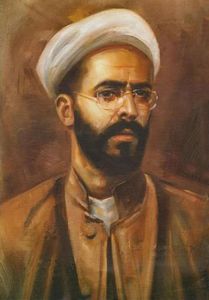National government in South Azerbaijan. Khiabani
“Independence of every nation is guaranteed by its valor and bravery.”
Sheikh Mohammad Khiabani
Armenian dashnaks formed armed units and attacked against Azerbaijan civilians, taking advantage of the fact, that Russian army had crossed into South Azerbaijan (an integral part of Iran)during World War I. Armenians burned over 500 houses, killed over 10, 000 Azerbaijanis in in the city of Urmia on March17,1918. While in the cities of Urmia, Salmas, Khoy, Maku and in surrounding areas was committed genocide against Azerbaijanis, the Ottoman troops entered Iran. Armenian armed forces were defeated. However, at that time 8,000 armed forces under the leadership of Andronik moved from Julfa towards the south with the aim of capturing the city of Khoy and consolidation with local armenian troops. Armenians planned to seize Khoy, to exterminate local Azerbaijan population, to settle here 10,000 armenian families which they had brought and to annex the region totally to Armenia. On June 24, Andranik surrendered Khoy.
But local residents had resisted and acted with excessive violence. The approach of the Ottoman army forced Andranik to retreat. So, the genocide committed against Azerbaijanis in South Azerbaijan was put an end. England was striving to gain Baku oil, and launched deploying army in South Azerbaijan. On August 9, 1919, under the pressure from invaders between England and Iran was signed the treaty, and with accordance with it Iran fell into dependence of England.
As a result of this treaty was launched people’s struggle against the venal government. People rose up for restoration of national traditions of statehood in South Azerbaijan. The chairman of the Azerbaijan Democratic Party, Sheikh Mohammad Khiabani led the struggle both against foreign occupants in South Azerbaijan and the government of Iran, which signed Anglo-Iranian treaty. The army of Khiabani put an end to the genocide committed against Azerbaijan population in the cities of Sharafkhan, Salmas, Urmia including other regions.
Political platform of Khiabani, that is known as tadjaddod (“striving for modernity”) was directed against imperialistic domination, shah’s power and social inequality. On April 7, 1920 people’s uprising took place in Tabriz, under the leadership of public governance council that was headed by Khiabani. On June 23, 1920, rebellious established National government that was headed by Khiabani. South Azerbaijan was named “Azadistan”- the land of freedom. National government struggled for democratization not only South Azerbaijan but including Iran entirely. Khiabani was concerned that “Tabriz would bring Iran success.” National government launched the reforms in the field of agriculture, education, finance, healthcare and justice. The national liberation and democratic movement under leadership of Khiabani has caused widespread concern and anxiety in Iran and state representatives of England in Iran. They developed the common plan of struggle. On September 12, the counter-revolutionary forces assumed a counter offensive. The Government center was captured in Tabriz. Mass repression began against the rebellious Khiabani was brutally killed.
However, the legendary page of Azerbaijani struggle for freedom went down in history. The Bolshevik regime of Soviet Russia put an end to AzerbaijanRepublic in North Azerbaijan and furthermore, Iranian shah regime quickly quenched Azadistan in blood in South Azerbaijan.
